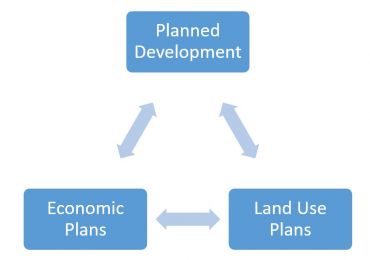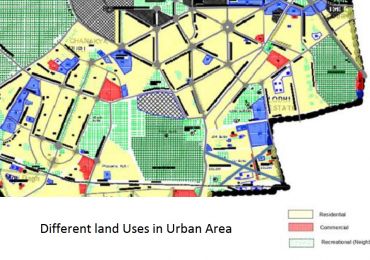History of Land Use Planning in India
Development in all forms is essential for all countries, for this purpose, various methods are adopted which include economic planning, spatial planning or/and any other suitable planning. Land use planning in India came with the emergence of the need for the planned development of towns and cities. Before independence, the need for planning was not very much required as the population, and the resource availability has a good ratio but with the passage of time and increase in population the condition of urban areas started deteriorating and the need to go for planned development was emphasized. Before independence development of towns and cities took place and various types of cities emerged. The type of the city was predominantly governed by their locations which played an important role in their function. For example, port cities were located on coastal areas and trade through sea routed took place in these cities. Development and more importantly “planned development” is possible by efficient use of available resources like land, air, water, soil, forests and other natural resources. For achieving efficiency and increasing output land use planning in India gained importance.

The emergence of town planning or city planning
The evolution of planning started in the form of Improvement trusts which were assigned the responsibility of checking health issues. There was a number of improvement trusts which existed their administrative boundaries defined the area under their jurisdiction. After some time along with the improvement trusts, municipalities were also established. The concept of assigning activities to a particular parcel of land took its basic form in working with these improvement trusts and municipalities. They prepared both theoretical or sector plans and spatial plans for various uses. Property tax or similar tax was collected on the basis of maps which had boundaries shown along with the plot number; this can be considered as the primary form of spatial planning.
Evolution of development authorities
As the cities grew in size and population, their functioning became even more complex. This increased complexity required a unique/ designated body to look after its development. In small cities and towns, many of the work is still under municipalities, and a development authority might not be present. However, in the case of large cities, the process of urban development was given to development authorities. These development authorities used various ways to govern and plan for development and monitoring. The method for administering growth included preparation of development plan (master plan/zonal plan/sector plan/sub-zonal plan/ layout plan/ local area plan etc.) and Town Planning Schemes (T.P. Scheme). The type of plan used depended on the state government as land is a state subject under the Indian constitution.
Current land use planning in India
Town or urban planning in India is relatively new. The importance of planning development is gaining attention as more and more people are exploring the ways for a better quality of life. Planning in India is done by various ways most important of which included Economic Plans in the form of Five Year Plans by Planning Commission which was renamed as NITI Aayog in 2015 which gives a sectoral allocation of money which will be spent in different sectors. Urban planning in India is done through various types of development plans. One such plan is a master plan which is made for urban areas which govern the growth of the urban areas. Other popular plans include Town Planning Scheme or TP Scheme which is widely adopted in Gujarat. The most important feature of all development plans dealing with spatial planning is land use planning. Land use planning in India is followed for all development purposes. One of the most essential parts of any spatial plan includes a land use plan which assigns a plan its spatial nature. The planning done is thus done called land use planning as it involves assigning the particular activity to a given parcel of land.
Importance of Land Use Planning in India
India being a developing country still has its large population engaged in agricultural activity but at the same time with a remarkable increase in GDP and rapid urbanization people are migrating to cities for various reasons like better job opportunities, health and educational facilities, better quality of life and to enjoy urban amenities. Because of the rapid urbanization which is mainly unplanned, the need to use the land resource in urban areas has become most important. Strain over the land is increasing at a rapid rate with an increase in population in urban areas. Farming in urban areas is not done as it is land intensive and because of this, they rely on the surrounding and the other regions to meet its requirement. The types and nature of activities taking place are vast and needs to be managed. This management of activities takes place by dividing activities into different categories and assigning a color to them.
Land use planning in India comes into consideration to manage the activities taking place in different areas. The activities coming up are on bases of land use of the particular area which is generally given in master plan which governs the development of urban areas. Only the activities which are conforming to the given/ decided master plan are allowed to take place in that area. This is done so as to avoid conflict in activities and to reduce the negative impacts of different activities. For example, industries are not provided near the residential area to reduce the negative health impact. This management is also done using zoning which involves segregating different activities in different places.
Colour coding for land use planning
Land use planning in India is done by employing color codes in the development plans. Different colors are assigned in the development plan like a master plan or TP scheme which indicates a particular land use. Different colors indicate different categories like residential, recreational, commercial, transportation, industrial, public and semi-public on the map. The land use colors followed in whole India are the same but with an exception for the commercial and public & semi-public spaces. The color coding differs in some states which include the use of red color to indicate commercial areas and blue color for public & semi-public land use while the vice versa is followed in most of the parts. So it is advisable to refer to the document/act which applies to the area if there is any confusion about the color coding before working. Residential areas are shown with yellow color in almost all areas in India; the green color is used for recreational areas.

Read about: Land Use Planning, Types of Development Plans in India, Delhi Master Plan 2021